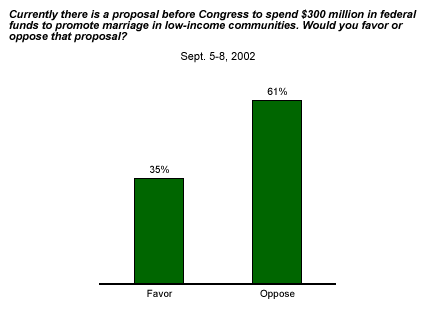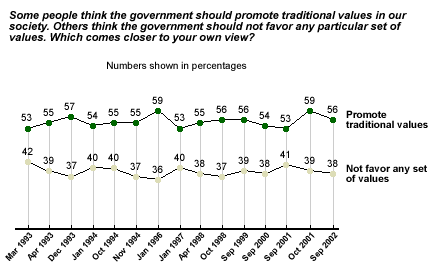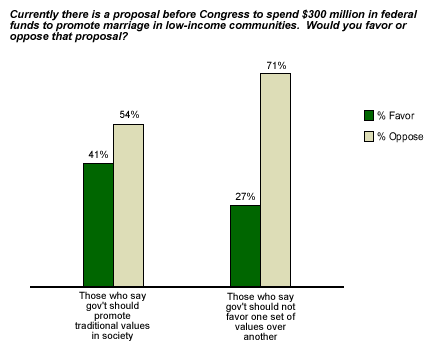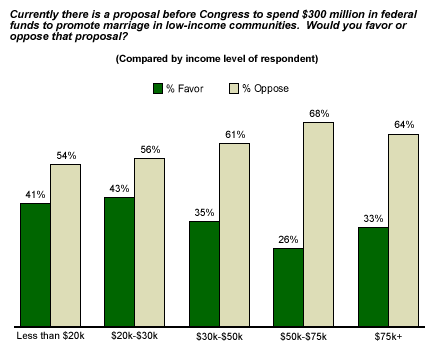President Bush wants to encourage low-income parents to get married, and to do that he has proposed spending $300 million of welfare funds to help in the effort. The money would be awarded in grants for such organizations as family-therapy centers and health clinics that offer courses in parenthood or pre-wedding counseling.
A recent Gallup Poll* asked Americans if they approve of such an idea and the answer appears to be an emphatic "no." Overall, 61% of Americans said they would oppose "a proposal before Congress to spend $300 million in federal funds to promote marriage in low-income communities," while just 35% said they would favor such a proposal.

These results may surprise those who have followed Gallup polling on American values. Since 1993, Gallup has asked Americans a general question about whether the government should promote traditional values in the nation, or whether it should not favor any set of values. Consistently, a majority has expressed support for government involvement in promoting traditional values, with about four in 10 Americans taking the opposing view.

One might expect that the question on promoting marriage would receive at least majority support among those who feel the government in general should promote traditional values. But a comparison of attitudes among those who favor, and those who oppose, government promotion of values as a general rule shows that majorities of both groups oppose the $300 million marriage-promotion proposal.

Not surprisingly, those who oppose government intervention in general express strong opposition to the marriage proposal, 71% to 27%. Those who favor government action as a general idea express somewhat more support for the marriage proposal, but still give it a thumbs down, 54% to 41%.
One reason why Americans who express support for government intervention in general reject the marriage proposal could be that the price tag seems high. One might support promotion of values in the abstract, but object to spending government money for such promotional activities. But Gallup experiments from the early 1990s suggest that money may not be the key to understanding the proposal's rejection.
In September 1992, Gallup asked people if they thought the government should "do more to promote traditional values," rather than just "promote traditional values." Support dropped dramatically when the question was asked in this manner: 40% favored government action, 54% opposed it.
And in August 1992, when Gallup asked a question mentioning a specific value area -- "do more to promote traditional family values" -- support dropped even further, even though no mention was made of spending any money for such promotion. (That same question, however, added a stronger statement of opposition, asking if the government "should stay out of these matters and not favor one set of values over another.") In this instance, 28% of Americans said the government should do more to promote traditional family values, and 67% said the government should stay out of these matters.
These results suggest that public opposition to the $300 million marriage proposal results more from its substance than its cost.
The Young and the Very Conservative Express Majority Support
The current poll finds majority support for the marriage proposal among the 7% of Americans who consider themselves "very conservative." However, among the rest of Americans -- who identify as "conservative" (but not "very"), "moderate" or "liberal" -- at least a majority opposes the idea.

Young adults (those under 30) are another subgroup of Americans expressing majority support for the proposal, with 51% in favor and 43% opposed. Among the other three age groups (30 to 49, 50 to 64, and 65 and older), opposition is about 2-to-1 or greater.

Since the proposal is targeted at low-income Americans, it is not surprising to see that support for the proposal is greater among lower income groups than higher income groups. Still, even the two lowest income groups express majority opposition.

*Results are based on telephone interviews with 1,004 national adults, aged 18 and older, conducted Sept. 5-8, 2002. For results based on the total sample of national adults, one can say with 95% confidence that the maximum margin of sampling error is ±3%. In addition to sampling error, question wording and practical difficulties in conducting surveys can introduce error or bias into the findings of public opinion polls.
